RARE DAVID SNAIR Crystalline Glaze Vase Studio Art Pottery 1975 Signed
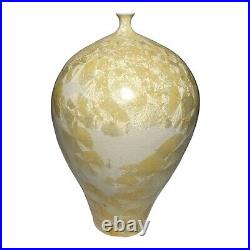
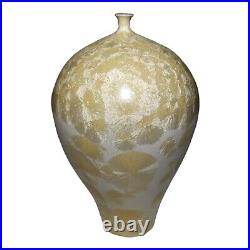



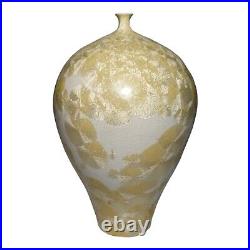
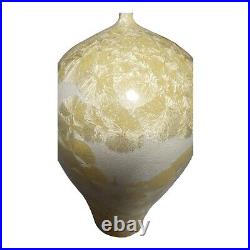
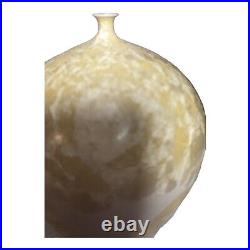
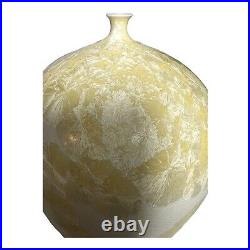
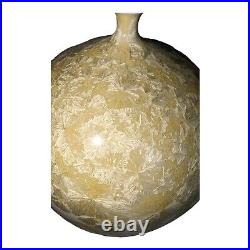

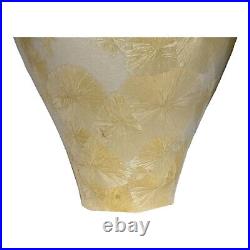
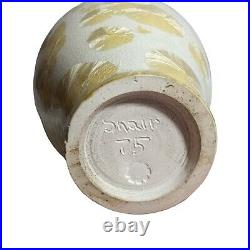

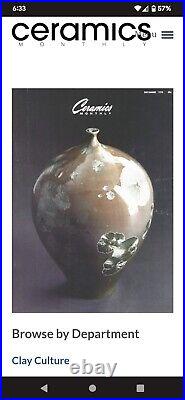
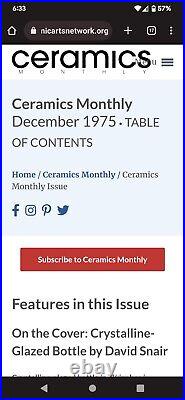

RARE DAVID SNAIR Crystalline Glaze Bud Vase Bulbous Bottle 1975 Signed Vintage. This is an incredibly rare bottle/weed vase, made by David Snair in 1975. Signed on the bottom. This same form was featured on the cover of the December 1975 issue of Ceramics monthly. David Snair was one of the founding fathers of US Crystalline Glaze. The amount of crystalline on this vessel is absolutely amazing, and beautiful. Measures approximately 7.5 tall. The top rim is 0.5 in diameter. The widest part of the vase is 4.75 in diameter. The bottom is 2 1/8 in diameter. 1 small chip on the bottom edge as shown in one of the last pictures. Snair received a BS in electrical engineering from Purdue University in 1970 and an MFA in ceramics in 1974. He taught at the Lafayette Art Center in Indiana. The Purdue University staff recommended David Snair as a ceramic graduate assistant and described him: His creative ceramic work has improved at a phenomenal rate and is now just about the most inventive and well thought out student work at Perdue. David Snair was the ceramics technician at Ohio State where he and Dawn King lived, experimented and worked with crystalline glaze. Crystalline glaze was created first in France at Sevres and later in America at the People’s University in University City, Missouri by Taxile Doat. Anything dealing with crystalline glaze was very secretive. The next American to work significantly was famed ceramist Herbert Sanders and one of his students who worked in Michigan, who influenced Snair. Snair’s knowledge of electricity and its properties led to his inventing a process for electroforming on clay by first applying metallic luster glaze, firing it and then using the standard electrical deposit methods by passing a current through the luster with the pot in a liquid bath of metallic salts. Crystalline glazes require frit, a special ground glass in order to keep the glaze’s alumina content very low. Snair had Fusion Corporation manufacture a special batch of frit to his specification. Snair published in the December 1975 issue of Ceramics Monthly about crystalline glaze recipes. In crystalline glassmaking, everyone prior to David was quite pleased with any result of this naturally occurring handsome effect (when a glaze composition low in alumina and high in zinc is melted and runs on a pot). Their results had lots of crystals sometimes in colors contrasting with their backgrounds, but usually crowded. What made Snair’s crystalline glazes better than any of his predecessors was that he eventually developed a method to place the crystals where he wanted them, often with just one or two on a single pot. He did this by placing a single ceramic fiber (the kind developed for the space shuttle and used as ceramic kiln insulation) in, and or, on the surface of the clay, applying the glaze and then heating the ware until nearly all the crystals ran off the pot to the catch basin below. But the single ceramic fiber would catch and propagate that single crystal. It was a brilliant discovery that came from David’s backgrounds of scientific experiment and art combined. He was clearly a genius at creative experiment. The Electroformed Metals on Clay in the September 1979 issue of Ceramics Monthly was a collaboration between David Snair and Dawn King. King exhibited porcelain containers with electroformed-metals decorations as well as objects with local-reduction copper red and celadon glazes. Snair’s ceramic art collections can be seen at Ohio State University Museum, Columbus Museum of Art, Massillon Museum in Ohio, the Lannan Foundation, U. Gypsum, and the Edward Orton Jr. He exhibited at the 1973 Mid States Craft Exhibition; the Indianapolis Museum of Art; the 1974 Biennial Michiana Regional Art Competition; the Mansfield Art Center 1975; the Nat’l Cone Box Show in 1975, and many more. Toward the very end of his time in Columbus, David turned a corner in his truck in his neighborhood and struck and killed an elderly woman. When both of them moved to California their relationship became strained and the couple separated. Snair felt that the light in California was different and as a result his work did not sell well. We do not know what has happened to David Snair and Dawn King after their initial move to California. This is one of those sad genius stories of brilliance that is inflicted with problems. Written by Bill Hunt.

Barbara & Michael Hawkins Port Isaac studio pottery large Poppy vase Rare Carn Studio Pottery Cornwall Vase, Signed John Beusmans N11, 1978-1986
Comments are currently closed.